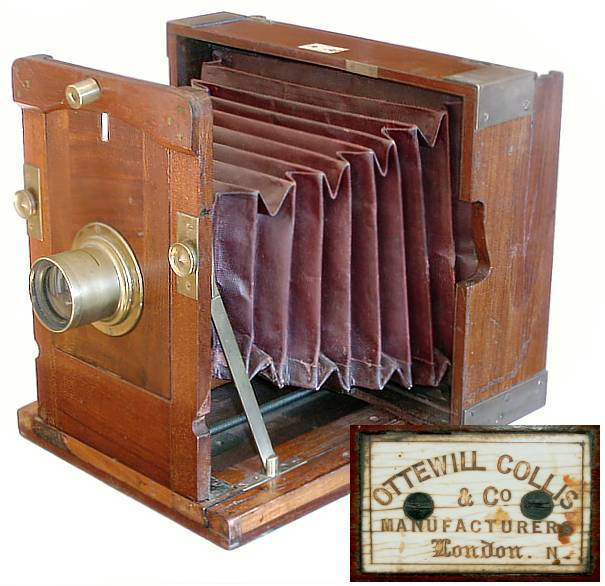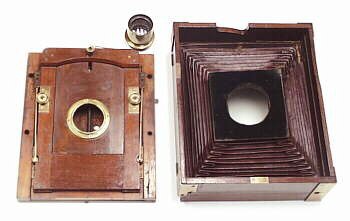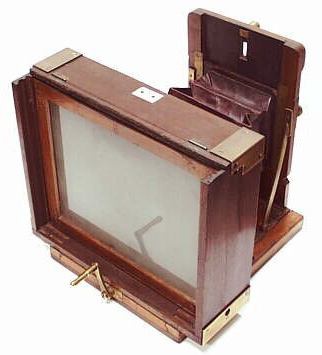|
|





Copyright ©2003 by Rob Niederman - ALL RIGHTS RESERVED
Return to the View Cameras page
The first successful commercial use of bellows in 1851
was a milestone in camera design. It provided a
lightweight method of extending body sections. The
original bellows pattern was "square," implying that the
sides were parallel to each other. Before using a bellows,
makers created heavy wood "sliding box" cameras.
In 1857, the Scottish photographer C.G.H. Kinnear invented a camera that influenced the design pattern for all future bellows apparatus. Kinnear's new camera used a tapered bellows, which enabled it to fold into a very compact form because each pleat nested into the next, larger pleat.
The newly designed wood body was also innovative. A lens panel was mounted on the front of a sliding base that could be extended or retracting (for focusing) by an endless screw. A handle at the back of the base was used to focus the camera.
To ensure portability, Kinnear designed the camera so it could be completely disassembled and stored inside the rear standard.
Collapsing the camera for storage was relatively straight forward. The front of the bellows was removed from the lensboard and pushed into the rear standard. The rear standard was then unbolted from the base. Supporting rods locking the lensboard were unlocked, which allowed the lensboard to be folded flat against the camera base. The entire camera base (including lensboard) was flipped over and put on top of the rear standard. Small sliding brass latches would lock the base to the rear standard. In a sense, the Kinnear pattern camera could be considered one of the earliest "self-contained" designs.
In 1857, the Scottish photographer C.G.H. Kinnear invented a camera that influenced the design pattern for all future bellows apparatus. Kinnear's new camera used a tapered bellows, which enabled it to fold into a very compact form because each pleat nested into the next, larger pleat.
The newly designed wood body was also innovative. A lens panel was mounted on the front of a sliding base that could be extended or retracting (for focusing) by an endless screw. A handle at the back of the base was used to focus the camera.
To ensure portability, Kinnear designed the camera so it could be completely disassembled and stored inside the rear standard.
Collapsing the camera for storage was relatively straight forward. The front of the bellows was removed from the lensboard and pushed into the rear standard. The rear standard was then unbolted from the base. Supporting rods locking the lensboard were unlocked, which allowed the lensboard to be folded flat against the camera base. The entire camera base (including lensboard) was flipped over and put on top of the rear standard. Small sliding brass latches would lock the base to the rear standard. In a sense, the Kinnear pattern camera could be considered one of the earliest "self-contained" designs.
Multi-Lens Cameras | View Cameras | Self-Casing Cameras | Solid Body Cameras | References & Advertisements
Home | What's New | Show Schedule | Wanted | For Sale | Links | Site Map | Email
Home | What's New | Show Schedule | Wanted | For Sale | Links | Site Map | Email
By 1859, English makers such as W.W. Rouch and Thomas Ottewill copied Kinnear's landmark camera and improved on the design. All
Kinnear-pattern cameras made in the 1860s and 1870s are top loading wetplate designs and relatively rare. Dry-plate versions were made in the
1890s.
Improved Kinnear Camera, 1860s
Ottewill Collis & Company, London
Ottewill Collis & Company, London
This particular camera is an 8 x 10 inch example with an "Ottewill Collis & Co., Manufacturers"
maker's label. It is believed that Thomas Ottewill teamed with Collis from 1864 to 1868.
Ottewill's Improved Kinnear camera is an early top loading design with a reversible back and a
red Kinnear bellows. Unlike modern cameras, Kinnear bellows do not have chamfered corners
and are constructed with a corner seam.
An early and important British maker, Thomas Ottewill first started making cameras in 1851. He is best known for his "Double Folding Camera" (1853) that could be folded once the front and rear standards were removed. Two of the most famous English builders, George Hare and Patrick Meagher, worked for Ottewill before going into business for themselves.
An early and important British maker, Thomas Ottewill first started making cameras in 1851. He is best known for his "Double Folding Camera" (1853) that could be folded once the front and rear standards were removed. Two of the most famous English builders, George Hare and Patrick Meagher, worked for Ottewill before going into business for themselves.
Rear view showing the a collapsible focusing crank. A
second set of mounting holes (on the right) secure the
entire rear assembly when it is reversed for portrait work.
second set of mounting holes (on the right) secure the
entire rear assembly when it is reversed for portrait work.
Collapsing the camera is done by removing the bellows
from the lensboard and unbolting the rear standard from
the base. The lensboard is folded against the base after
the supports are unlocked. A curved notch in the rear
standard accommodates the brass focusing handle when
the camera base is inserted into the rear standard.